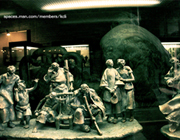This ancestral temple was built between 1890 and 1894 during the reign of Emperor Guangxu of the Qing dynasty, and is the largest, best preserved, and best decorated ancient architecture existing in Guangdong province.
It was built with donations of the Chen family then spread in 72 counties in Guangdong province. The temple used to provide lodgings for candidates of the Chen family who came to Guangdong to prepare for imperial examinations in Guangzhou. Hence it was also called Chen Clan Academy.
Occupying an area of 15,000 square meters, the temple is composed of six courtyards, nine main halls, and nineteen buildings. With a traditional Guangdong style architecture, the temple is especially renowned for its beautiful decorations. In the temple, historical figures, legends, and sceneries are presented with many art forms, including wood, brick, stone and lime carving, pottery,  clay and ash sculpture, brass and iron cast, grotto, etc. The artistic and historical values made the temple an important attraction in Guangzhou.
clay and ash sculpture, brass and iron cast, grotto, etc. The artistic and historical values made the temple an important attraction in Guangzhou.
In 1986, it was designated as an important cultural relic by the State Council. The temple is now the site of the Museum of Guangdong Folk Arts and Crafts.